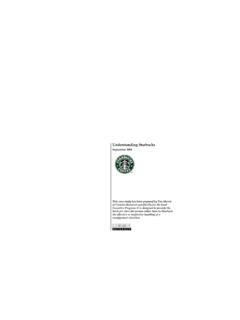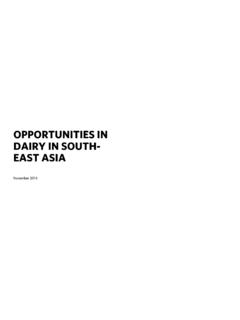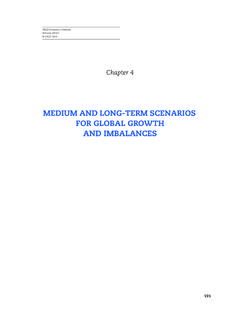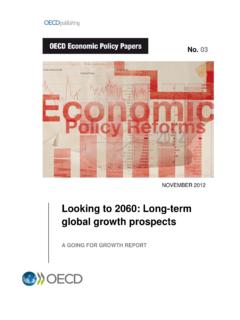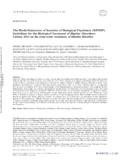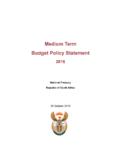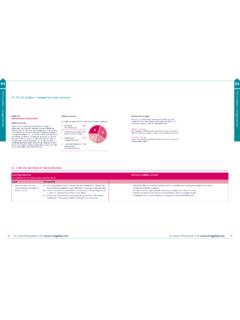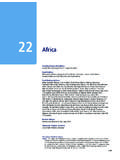Transcription of with funding from the - Research Consulting Strategy
1 OVERVIEW OF THE NEW ZEALAND APPLE INDUSTRY IN A global CONTEXTR eport prepared forPipfruit New Zealandwith funding from theMinistry of Economic Development December 20062 PipfruitIntroductionCoriolis Research Ltd. is a strategic market Research firm founded in 1997 and based in Auckland, New Zealand. Coriolis primarily works with clients in the food and fast moving consumer goods supply chain, from primary producers to retailers. In addition to working with clients, Coriolis regularly produces reports on current industry topics. Recent reports have included an analysis of Retail Globalization: Who s Winning and an Overview of the Growth of Foodservice. The coriolis force, named for French physicist Gaspard Coriolis (1792-1843), may be seen on a large scale in the movement of winds and ocean currents on the rotating earth.
2 It dominates weather patterns, producing the counterclockwise flow observed around low-pressure zones in the Northern Hemisphere and the clockwise flow around such zones in the Southern Hemisphere. It is the result of a centripetal force on a mass moving with a velocity radially outward in a rotating plane. In market Research it means understanding the big picture before you get into the details. PO BOX 10 202, Mt. Eden, Auckland 1030, New ZealandTel: +64 9 623 1848; Fax: +64 9 353 1515; email: SCOPE This report is one of the building blocks for the development of a comprehensive New Zealand pipfruit industry Strategy Pipfruit New Zealand on behalf of the pipfruit industry, with the assistance of the Ministry of Economic Development has initiated the development of a pipfruit sector Strategy The Strategy will focus primarily on the long term future of the pipfruit industry and will identify the changes necessary for New Zealand to maintain international competitiveness Following the terms of reference, the process for developing and deploying the Strategy will include:1.
3 Consultation widely throughout the pipfruit value chain and associated sectors2. A brief examination of the current state of the New Zealand pipfruit industry and the factors onshore and offshore that have generated the current situation3. A rigorous analysis of international pipfruit markets and how the New Zealand industry can compete: this will include a competitor comparative analysis and an examination of where NZ s future opportunities lie4. An assessment of the changes that are necessary to secure the long-term future of the industry. This will include: Development and testing of future scenarios and analysis of potential outcomes Analysis of potential roadblocks and possible solutions to them5. The development of a shared vision for the NZ pipfruit industry6. Implementation steps for all major stakeholders Innomarc Consulting , in conjunction with Coriolis Research and a consortium of other industry researchers and experts, is developing this Strategy under the governance of the Project Steering Group 4 PipfruitIntroductionPROJECT STRUCTURE This report provides an overview of the current state of the New Zealand pipfruit industry and its competitors and markets This report is structured to answer two points from the terms of reference1.
4 A brief examination of the current state of the New Zealand pipfruit industry and the factors onshore and offshore that have generated the current situation2. A rigorous analysis of international pipfruit markets and how the New Zealand industry can compete: this will include a competitor comparative analysis and an examination of where New Zealand s future opportunities lie5 PipfruitIntroductionPROJECT LIMITATIONS This report has a number of limitations Available historical data on the New Zealand pipfruit industry is poor and inconsistent. Government budget cuts in the 1990 s and the deregulation of the industry exacerbated this problem. The numbers in this section come from a number of sources. While we believe the data is directionally correct, we recognise the limitations in what information is available.
5 In many cases different data sources disagree ( HortResearch vs. MAF vs. Statistics New Zealand). Many data sources themselves incorporate estimates of industry experts. We have chosen to primarily focus our limited time and budget more on apples than pears. We have done as we believe that without a successful apple industry and the scale it brings, there is little hope for the pear industry. Pears represent less than 10% of total pipfruit area and take the same amount of time, resources and effort per variable to analyse. If you have any questions about the source or meaning of a number in this report, please contact the project leader, Tim Morris at Coriolis Research on (09) 623 18486 PipfruitIntroductionDOCUMENT STRUCTURE This report is structured as followsKey players in the supply chain for New Zealand apples(model)UnitedKingdomPacker/Shipper ExporterGrowersDomesticMarketUnitedState sAsiaPacific Islands & OtherNew Zealand IndustryEuropeSouthAfricaOtherCompetitor sKey CompetitorsChile1 PipfruitIndustrySECTION 1 The first section of this report looks at the changing structure of the New Zealand industryKey players in the supply chain for New Zealand apples(model)
6 UnitedKingdomPacker/ShipperExporterGrowe rsDomesticMarketUnitedStatesAsiaPacific Islands & OtherNew Zealand IndustrycEuropeSouthAfricaOtherCompetito rsKey CompetitorsChile2 PipfruitIndustrySUMMARY: NEW ZEALAND APPLE INDUSTRY - WHAT HAPPENED? Pre-1995 new apple varieties and the innovation of using medium density rootstock resulted in New Zealand showing strong growth in; the area planted under apples, production, productivity and export prices of apples. This lead to New Zealand being regarded as the most competitive supplier in the world. Many new entrants entered the industry seeking high returns. Pipfruit growers numbers more than doubled in the 10 years from 1985 to 1995. The high did not last. Prices for apples over the past 20 years fluctuated wildly. Prices hit an all time low in 1997, rose again in 2000/2001 following industry deregulation, only to fall back down to almost the lows of the late 90 s.
7 The drop in prices had a dramatic impact on the industry. There was a drop in overall area planted and production. Many growers and pack houses exited the industry. A stronger concentration of production developed in the Hawkes Bay and Nelson as growers exited secondary regions. New varieties are in the pipeline and yields are still increasing but the industry is in crisis as farm gate costs are more than the apple 1 A PAT ON THE BACK The New Zealand pipfruit industry experienced a long period of growth through the post-war period leading to strong production and export volume growth New Zealand achieved superior export prices for its fruit relative to its competitors ( Chile) The New Zealand pipfruit industry has a long history of innovation New Zealand achieved superior production per hectare - when compared with similar developed countries In 1995 The World Apple Report declared New Zealand to be the most competitive apple supplier in the world4 PipfruitIndustrySTRONG INPUT GROWTH The New Zealand pipfruit industry experienced a long period of growth through the post-war of pipfruit growers in New Zealand(growers; 1925-1995)Area planted in apples in New Zealand(hectares; 1925-1995)Source: NZAPMB; PNZ; Department of Statistics; Statistics New Zealand; MAF; FAO.
8 Coriolis estimates and analysis5,5113,9204,8612,7652,8003,7905, 2027,22615,91619251930193619491955196519 7519851995n/a1,4891,0327167207407427701, 6001925193019361949195519651975198519955 PipfruitIndustrySTRONG OUTPUT GROWTH ..leading to strong production and export volume growthApple production volume in New Zealand(tonnes; 1925-1995)Apple export volume from New Zealand(tonnes; 1925-1995)Source: NZAPMB; PNZ; Department of Statistics; Statistics New Zealand; MAF; FAO; Coriolis analysis28,36439,59059,90040,07846,94110 2,900159,403276,594527,00019251930 19361949 1955 19651975 198519953,85917,18026,2018,89717,45442,9 5079,713146,755302,41519251930 193619491955 19651975 198519956 PipfruitIndustry$-$ $ $ $ $ $ $ $ $ $ RETURNS New Zealand achieved superior export prices for its fruit relative to its competitors ( Chile)New Zealand FOB export apple price per kilogram(inflation adjusted 1986 US$; 1970-1996)Note: Uses FOB data deflated with US producer price index; No Chile 2005 data yet available; Source: FAO.
9 US DOL BLS; Coriolis analysisNew (70-96)+130%7 PipfruitIndustryHISTORY OF INNOVATION The New Zealand pipfruit industry has a long history of innovation1814 Group of English missionaries led by Reverend Samuel Marsden introduce apples to New Zealand1890 sNew Zealand begins exporting small quantities of apples and pears1924 James Hutton Kidd develops Kidd s Orange Red (Cox s Orange Pippin x Delicious) in Greytown, Bixley discovers Red Dougherty (sport of Australian Dougherty) in Twyford, Hawkes Bay1930 Research orchard under DSIR established at Appleby in Kidd develops Gala (Kidd s Orange Red x Golden Delicious) on his property in Greytown, Wairarapa; variety named Gala in 1965 by Dr. McKenzie, DSIR; derivative Royal Gala named in honour of visit by Queen Elizabeth II to New Zealand 1948 Charles L. Roberts discovers Splendour in garden in Napier1952 Braeburn discovered on property of O.
10 Moran in Upper Moutere, Nelson; first grown commercially by William Bros., Braeburn Orchards1956 New Zealand sends first shipment of Granny Smith apples to the United States market1960 sDon McKenzie proposes adoption of central leader shape and M106 rootstock leading to tree densities increasing from 275 to 670 trees per hectare; industry becomes world leader in production per hectare1990 sDevelopment of Pacific series and Jazz2005 HortResearch establishes PREVAR to commercialise new pipfruit varieties and generate a NZ$ annual income stream to fund fruit Research ; three other shareholders are Pipfruit NZ, APAL and AIGN Key events in history of New Zealand pipfruit industry(various)8 PipfruitIndustrySUPERIOR PRODUCTION PER HECTARE New Zealand achieved superior production per hectare - when compared with similar developed countriesApple production per hectare: New Zealand vs.
